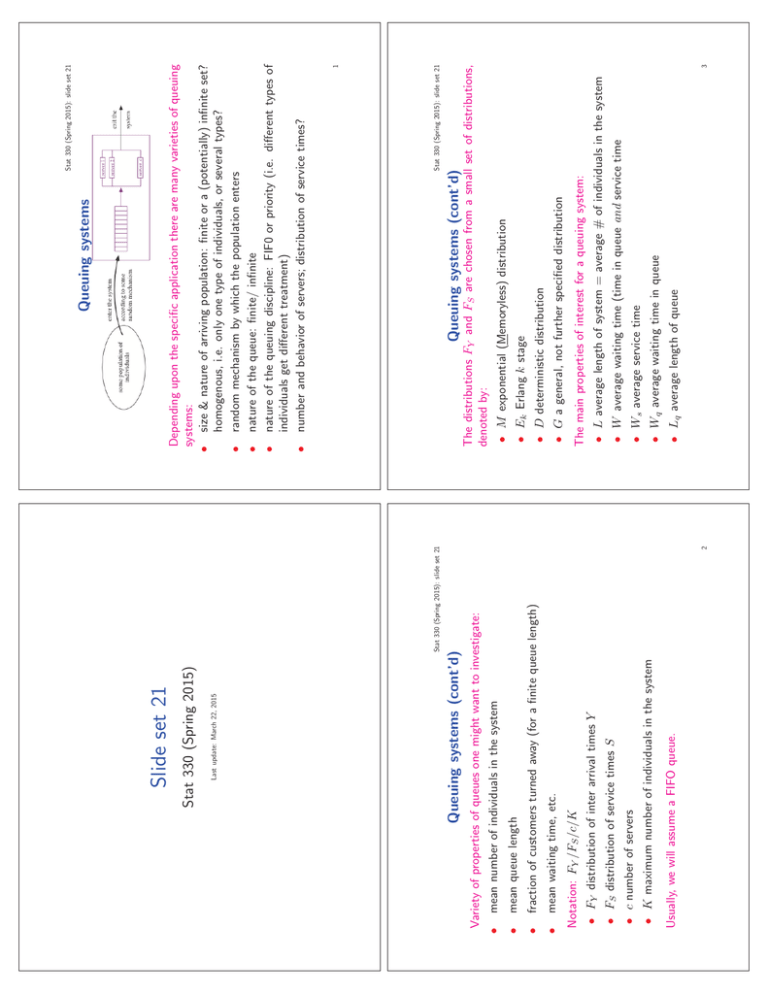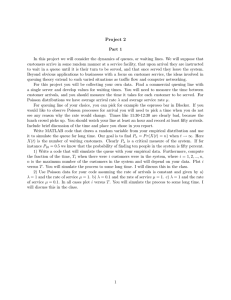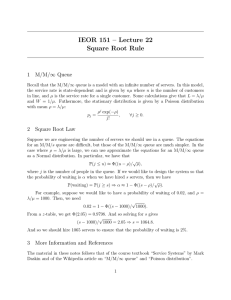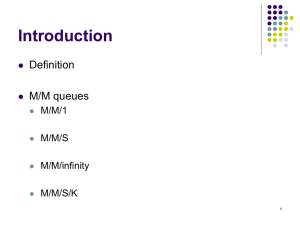systems
advertisement

mean queue length fraction of customers turned away (for a finite queue length) mean waiting time, etc. • • • Usually, we will assume a FIFO queue. • K maximum number of individuals in the system • c number of servers • FS distribution of service times S • FY distribution of inter arrival times Y Notation: FY /FS /c/K mean number of individuals in the system • Variety of properties of queues one might want to investigate: 2 Stat 330 (Spring 2015): slide set 21 Queuing systems (cont’d) Last update: March 22, 2015 Stat 330 (Spring 2015) Slide set 21 Stat 330 (Spring 2015): slide set 21 • Lq average length of queue • Wq average waiting time in queue • Ws average service time • W average waiting time (time in queue and service time • L average length of system = average # of individuals in the system The main properties of interest for a queuing system: • G a general, not further specified distribution • D deterministic distribution • Ek Erlang k stage • M exponential (Memoryless) distribution Queuing systems (cont’d) 3 The distributions FY and FS are chosen from a small set of distributions, denoted by: Stat 330 (Spring 2015): slide set 21 1 Depending upon the specific application there are many varieties of queuing systems: • size & nature of arriving population: finite or a (potentially) infinite set? homogenous, i.e. only one type of individuals, or several types? • random mechanism by which the population enters • nature of the queue: finite/ infinite • nature of the queuing discipline: FIF0 or priority (i.e. different types of individuals get different treatment) • number and behavior of servers; distribution of service times? Queuing systems Stat 330 (Spring 2015): slide set 21 Relationship between properties where 6 For c servers and an overall capacity of K (where K may be = ∞) the transition diagram looks like this: A way to visualize what is going on in the queuing system is the birth & death transition diagram. pk = limt→∞ P (N (t) = k). 7 The problem of finding the steady state probabilities of the B&D process is equivalent to finding the steady state probabilities for the number of individuals in the queuing system, This ratio is called the traffic intensity a. For a M/M/1 queuing system, the traffic intensity is constant for all k. Let N (t) denote the number of individuals in the system at time t, N (t) can then be modeled using a Birth & Death process: λk = birth rate = arrival rate = λ for all k μk = death rate = service rate = μ for all k We’ve already seen that the ratio λ/μ is very important for the analysis of the B&D process. Situation: exponential inter arrival times with rate λ, exponential service times with rate μ. Stat 330 (Spring 2015): slide set 21 Stat 330 (Spring 2015): slide set 21 Birth & Death Transition Diagrams 5 The M/M/1 Queue To choose the easier way of computation, the following overview of the relationships between these properties helps: 4 λ̄ is the average rate at which individuals enter the system. W is the average time spent in the system, and L is the average number of individuals in the system, L = λ̄ · W Little’s Law: For a queuing system in steady state For computing the properties L, W, Ws, Wq , Lq there are usually two different ways: an easy way and a difficult one. Ls = λ¯s · Ws. • This gives us a way to analyze the queuing systems using the methods from the previous chapter. This theorem can also be applied to the queue itself: Lq = λ¯q · Wq or to the server • The theorem below links waiting times to the number of people in the system and will be very useful in the future Stat 330 (Spring 2015): slide set 21 More on Little’s Theorem • We model the number of individuals in the system at time t as the Birth & Death Process X(t) • The main idea of a queuing system is to model the number of individuals in the system (queue and server) as a Birth & Death Process. Model queueing systems as Stochastic processes Stat 330 (Spring 2015): slide set 21 = ak (1 − a) Wq = W − Ws = 1 · μ 1 −1 1−a = 1 a . μ1 − a 10 Since we know that service times are exponentially distributed with rate μ, the the average waiting time is Ws = μ1 . Thus, the closer the service rate is to the arrival rate, the larger is the expected number of people in the system. a2 1−a 11 Clearly, the distribution of the waiting times depends on the number of individuals already in the queue at time t. Distribution of time in the queue: Denote by q(t) the time that an individual entering the system at time t has to spend waiting in the queue. This is the server utilization rate. Further we see, that the long run probability that the server is busy is given as: P (server busy) = 1 − P (system empty) = 1 − p0 = a. L q = Wq λ = The average length of the queue is, using Little’s Law again, is: The M/M/1 Queue (cont’d) Stat 330 (Spring 2015): slide set 21 The overall time spent in the system is a sum of the time spent in the queue Wq and the average time spent in service Ws i.e. W = Wq + Ws Thus, the average time spent waiting in the queue is: 1 a . −1= 1−a 1−a Stat 330 (Spring 2015): slide set 21 The mean time spent in the queueing system, W is then, using Little’s Law: 1 1 · μ 1−a t→∞ Note that L gets larger as a gets closer to 1, that is, as the service rate gets closer to the arrival rate. t→∞ L = lim E[N (t)] = lim E[N (t) + 1] − 1 = The average number of individuals in the queuing system, L, is limt→∞ E[N (t)]: We can use that to get the expected value of N (t): It is a modified geometric distribution, as N (t) can be 0 (empty system). Thus N (t) + 1 has a Geometric distribution Geo(1 − a). 9 The M/M/1 Queue (cont’d) W = L/λ = Stat 330 (Spring 2015): slide set 21 The M/M/1 Queue (cont’d) 8 N (t) therefore has a (modified) geometric distribution for large t! pk ... p3 = a3(1 − a) p2 = a2(1 − a) p1 = a(1 − a) p0 = 1 − a We have a system with a steady state if a < 1. ∞ 1 If a < 1 S = k=0 ak = 1−a , then The B&D balance equations then say that 1 = p0(1 + a + a2 + . . .) The M/M/1 Queue (cont’d) Stat 330 (Spring 2015): slide set 21 for large t 12 We can put those pieces together in order to get the large t distribution for q(t) using the the total probability law. q(t)|X(t) = k ∼ Erlang(k, μ) This is a conditional distribution, since it is the distribution of q(t) given that the number of people in the system is k: If there are k individuals in the queue, the waiting time q(t) is Erlang(k, μ) (i.e., k departures with departures occurring with a rate of μ). limt→∞ P (q(t) = 0) = p0 = 1 − a. For large t we therefore get: The individual entering the system doesn’t have to wait at all in the queue when the system at time t is empty. The M/M/1 Queue (cont’d) = −x/W 1 − ae , = k=1 ∞ k−1 j −μx (xμ) p0 + (1 − e )pk = . . . j! j=0 k=1 ∞ (1 − P oμx(k − 1))pk P (q(t) ≤ x|X(t) = k)pk P (q(t) ≤ x ∩ X(t) = k) 1 μ 1 · 1−a = now use total probability law! p0 + k=0 ∞ k=0 ∞ P (q(t) ≤ x) = = = = = where W is the average time spent in the system, W = Fq(t)(x) For large t and x ≥ 0: 1 μ−λ . 13 Stat 330 (Spring 2015): slide set 21 The M/M/1 Queue (cont’d)




